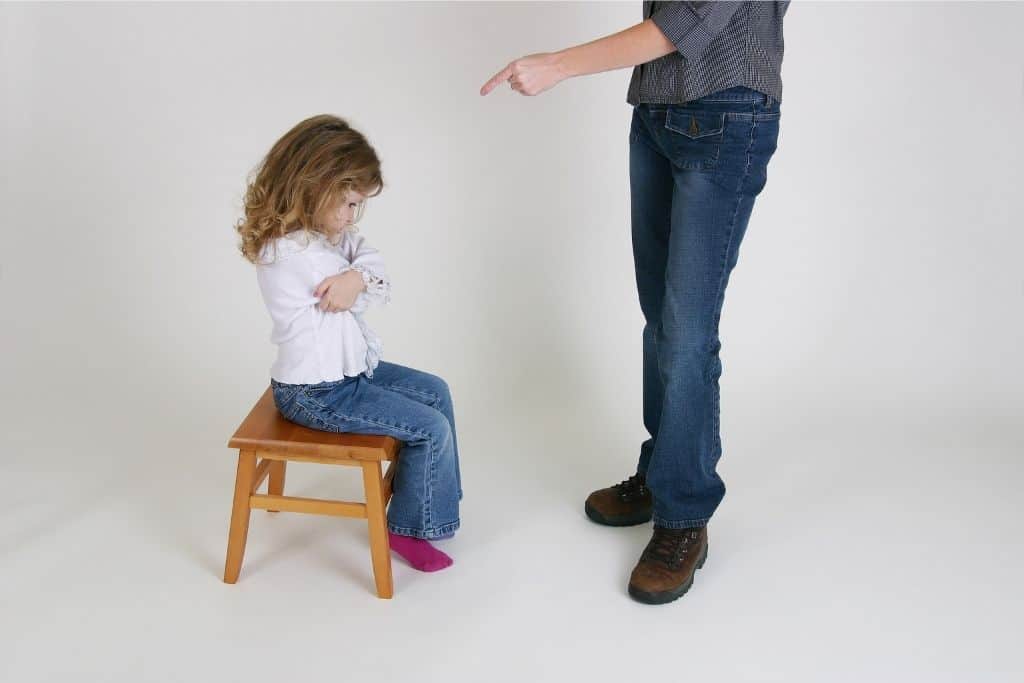The Right Mindset for Setting Firm Limits
In this article, I will explain why children need firm limits and how we can hold firm limits for our children. This is one of the five main criteria for Positive Discipline, and I find it to be the secret key to parenting successfully. However, setting firm limits while maintaining kindness is a very hard thing to do.
Table of Contents
Eliminate Fear
I am sure many of you experience some of these:
- your kids don’t like to pick up their toys
- they don’t come to dinner when you ask them
- they lie
- don’t listen, etc.
Our neighbors, family, and culture in general tell us that we have to lay down the law and make our children listen. Otherwise, they will become spoiled, entitled brats, with no respect for others. Or worse, delinquents, because, you know, they sneaked into the pantry and stole chocolate before dinner when they were 5.
These thoughts are not true. They are fear-based and fear makes us want to control. And coming down hard on our kids is not helpful. Yet I do believe that setting and holding firm limits is a necessary aspect of parenting. At the same time, it is a very tricky one to master.
In this article, I will give you a solid framework to get you started with setting limits firmly and kindly.
The first thing you need in order to be able to hold firm limits is a certain mindset. And that’s what I’ll help you achieve here. If we can reframe limits, we can eliminate the anxiety around them.
We’ve Got Firm Limits All Wrong
We’ll begin by looking at most people’s misconceptions about firm limits and what they are in reality.
Misconceptions Around Firm Limits
When we hear the phrase ”firm limits”, many of us think we have to be stern with our children. Although firm and stern may seem similar, they are not synonyms, nor are they related in any way.
When I say the word “stern”, I imagine someone with a frown, a harsh voice, and a hard heart. If I’m a child, this person may feel quite scary or threatening.
Firm, on the other hand, means not easily disturbed, strong, solid, and secure, resisting stress and pressure. Think of a firm mattress, firm muscles, or a firm apple. There’s nothing scary about them. You can press your fingers on the apple, but its shape will not change. You can sit on the mattress, and as soon as you stand up, it will bounce right back. Do you see the difference?
So why do we think that, in order to set firm limits for our children, we need to be scary or hostile? There is no need to raise our voices, yell, glare, scowl, or punish.
A firm limit is strong, solid, and unyielding; just like the skin of an apple. It also gives us a sense of certainty and security. We know we can push against the firm skin of the apple, and it will not break.
If we go off of definitions of the word “firm” in the dictionary, holding a limit firmly actually means not changing, being unwavering, despite any vicissitudes.
In our case, those vicissitudes would include our children’s emotional reactions, opposition, backtalk, lamenting, stalling, demands, and so on.
As you can see, a misunderstanding of what firm limits really are can lead to a lot of confusion about how to implement them.
I suspect our misunderstanding of the true meaning of firm limits comes from the way we were parented.
Most of us were raised in an authoritarian style, a “because I said so” type of discipline. And we imagine this is what firm limits are about. We tend to equate firm limits with authoritarianism.
Related: What to Do When Your Child Calls You “Stupid”
The Way We Were Parented Determines Our Own Parenting Style
And here is where things get even trickier. The way we were parented determines our own approach to raising our children.
As a result of the way that we were parented, two things may happen.
1. We become our parents
One is that we may unconsciously replicate our parents’ discipline style. The only familiar parental image that we have is the one we grew up with. So we are highly likely to emulate this image.
2. We swing in the opposite direction
However, if we have a certain degree of awareness that helps us see how our parents’ discipline style was detrimental to our well-being, then we may decide that we want to raise our kids differently.
But because we don’t know another way to parent, we may inadvertently slip into the other extreme.
If we have fears and guilt around setting limits, then we may unconsciously join the permissive camp. If we want to avoid being too permissive, then we may think being harsh is the only other way to keep kids on a straight path.
So, you see, it’s important to develop insight into the impact of our parents’ discipline approach on our own development. This insight helps us to analyze our own parental tendencies. At the same time, we also need new skills to help us implement the type of parenting that we know is best for our children.
Why Do Children Need Firm Limits?
Now let’s see why children need limits and what I mean by that.
To explain the importance of limits, I like to think of the analogy of a uterus.
The Uterus as a Limit
When children are in the womb, they are contained in a tight space, the amniotic sack. This is held firmly by the uterus, one of the strongest muscles in the body. Babies feel safe to grow in the warmth of their mother’s womb, even though it gets really tight really fast in there. They don’t seem to mind it though. They keep growing strong and healthy.
Sometimes the baby kicks and punches, stretches its legs and arms and pushes the wall of the tight uterine muscle. Do you remember when this happened? What was your reaction when you felt your baby push and punch?
I think it would be safe to say that all mothers are enchanted when they feel their baby move. We smile and caress the belly where we feel the little feet pushing. We don’t think the baby is naughty or manipulating, trying to gain something, or trying to break free. The baby is just growing and developing the bones, joints, and muscles that it will need to thrive once they come out of the womb. They will need all these body parts to be very strong so they can do well in the world.
Limits Are Natural and Safe
When babies are born, suddenly they lose this tight physical space that made them feel safe until then.
Now it is up to the parent to create a boundary for the child.
This time, it will not be a physical boundary, but a symbolic one. Imagine an invisible wall or muscle that creates a bubble around the child, similar to the uterus that they grew in for 40 weeks.
As the child grows and feels increasingly safe and confident, the space enclosed by this symbolic boundary, their safe bubble, will need to grow too. Because this is not a physical boundary that the child can see, they will try to push against it, to test it out. And they do this for two reasons:
- when they need to feel safe again
- and when they need to develop a new skill.
Related: How to Reduce Sibling Fights Easily
1. Children Need Limits to Feel Safe
When children need us to provide a strong limit that helps restore their sense of safety, they will do this in a variety of ways:
- by testing an existing limit
- having a big emotional outburst
- insisting they absolutely want something (like the blue shirt, not the yellow one, then something else)
- becoming stubborn about a routine or transition (for example bathtime, etc.)
Children do not know how to communicate clearly to us that they need to feel safe. Therefore the behavior that they are using for communication may confuse us.
What we have to understand is that children have a less developed brains than ours. Their brain just feels unsafe, so it launches the fight-flight response. Thus the backtalk or the stubbornness are behaviors that indicate a “fight” response. While the ignoring or stalling may be indicative of the “flight” response.
The smart thing for us parents to do is to not take children’s behaviors at face value but to always wonder what the need behind the behavior is.
Ramona Asztalos
2. Children Need Limits to Develop New Skills
Another reason why our children may push boundaries is when they need to develop new skills.
I am a firm believer that children know innately what skills they need and they will seek opportunities to develop them.
Let me tell you about my son and swinging. Initially, he wanted me to push him while he was tightly grasping the chains. After a while, he got used to the speed and the height, and he felt more comfortable to begin swinging on his own. And just the other day, I noticed him slowly putting his feet on the swing seat and pushing himself up until he was swinging while standing up on the seat. Then he carefully lowered himself again and continued swinging. No one urged him to do this. He just felt he was ready to push himself to the next level of difficulty.
And that’s what our children do. When they are in touch with themselves, children sense when they are ready to take the next steps to develop better skills.
When we trust our children’s development, we don’t stifle their inner motivation and their connection to themselves.
Ramona Asztalos
Holding Firm Limits Is Our Responsibility
Our job is to hold limits firmly for our children, lovingly and confidently. This will help them to feel safe and loved, and to develop the skills they will need in life.
When we trust that our children instinctively know what skills they need to develop, and when we trust that they are doing exactly what they need to be doing in order to develop those skills, then it becomes easier to lovingly and patiently hold a limit.
And if we can hold firm limits for our children, that is when they can grow and develop the strength, confidence, and resilience they will need to thrive in this world.
So reframing limits helps us to support our children’s development.
Related: How to Respond When Children Cry
Maintaining Confidence
Oftentimes, when children push back against our limits, it can feel triggering, and it can get exhausting pretty quickly. Or we may feel guilt-ridden for causing our child apparent distress. It can become very tempting to just let it go, bend the rule, give the child what they ask for, and let them be.
Other times, we may get into a power struggle and become rigid, holding the limit with anger and force. We tend to do this under the influence of our past conditioning and cultural pressures and expectations.
Either way, it can be very hard to maintain a level of confidence in our parenting and to fuel the connection with our children in the process.
For these reasons, it is important to stay focused on three things:
1. Increasing our awareness
Continuing to revisit our beliefs around limit-setting will help us to improve our awareness. We can catch ourselves when we tend to give in, because of discomfort, or when we become rigid, because of beliefs and outside pressure.
2. Detaching from triggers
Our child’s limit-pushing behavior has nothing to do with us. It is what they are meant to do, and it is not supposed to be easy.
We have to remember that it is our inner child who gets triggered. But our current children need us to show up as an adult. Therefore, we have to not take it personally and begin supporting our children however they may need it. And if it’s a limit they need, we have to provide it.
3. Committing to clear limits
Additionally, it helps to clarify why we are setting the limit and what the limit is. If we’re unsure, then we will not be convincing. And we will not have the commitment to our own limit. The commitment gives us the strength to hold a firm limit.
Action Plan for Setting Firm Limits
The next time you have to set and hold some firm limits with your child, here are the steps for entering the right mindset:
- You are the container – remember that your child needs limits to feel safe and to develop new skills. You are the firm container for your child’s development.
- Step back – the push-back is never about you, but rather it serves a need that your child has at that moment.
- Eliminate fear – a firm limit will not harm your child. Instead, it is the precise response to your child’s needs.
- Be compassionate – even though holding the limit is hard work, you still love your child and that has to come through.
- Be respectful – when we get triggered, it can be hard to remain respectful. Remember that your child is worthy and will come out as a wonderful person with your loving support.
Final Thoughts
The sweet spot for successful parenting is creating an environment that has high expectations while offering plenty of kindness and support. And this is how the Positive Discipline principle of having firm limits with kindness works.
I hope you can see now that we don’t have to be a spiky mattress in order to raise kids who are respectful and know to follow rules. Instead, we can be a firm mattress that offers comfortable support and hugs our children in love. Our firm and loving support is what our kids need to grow into happy and resilient adults.







